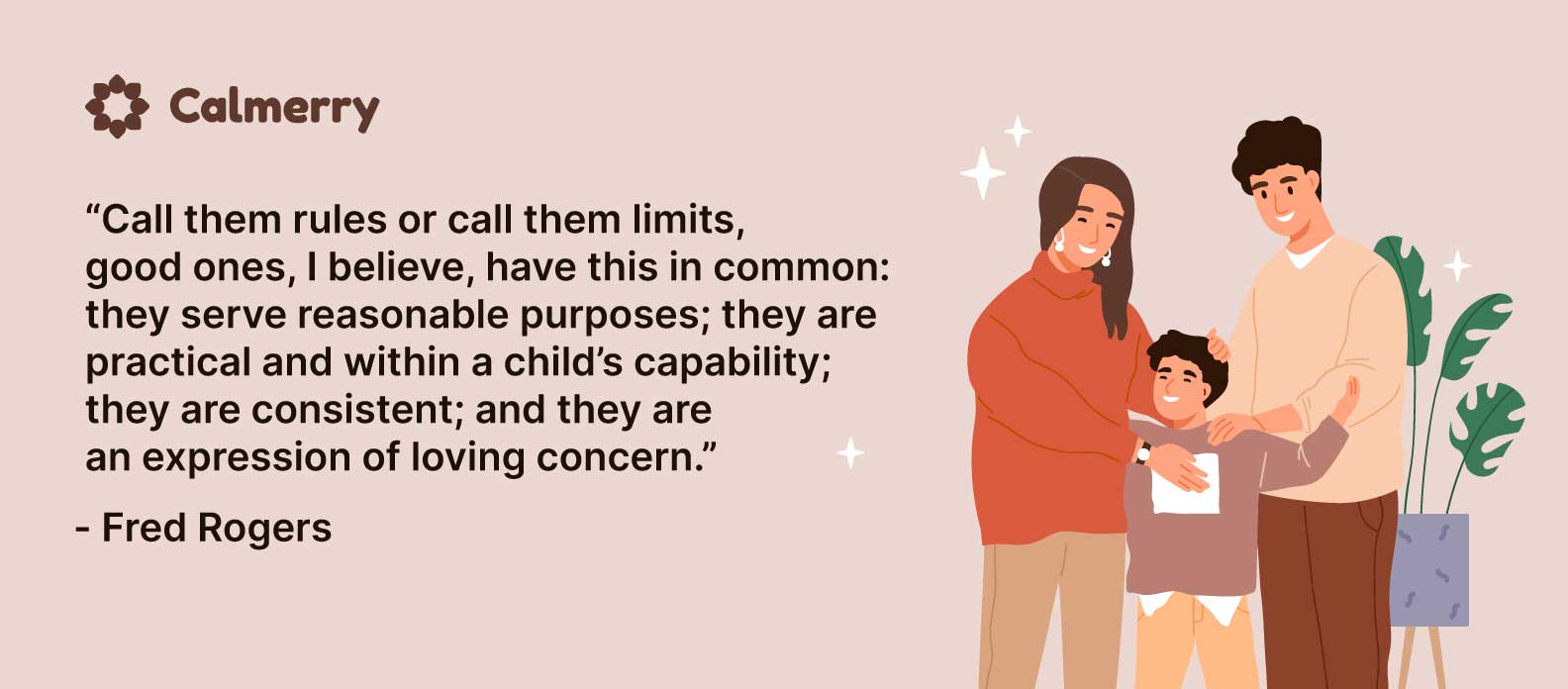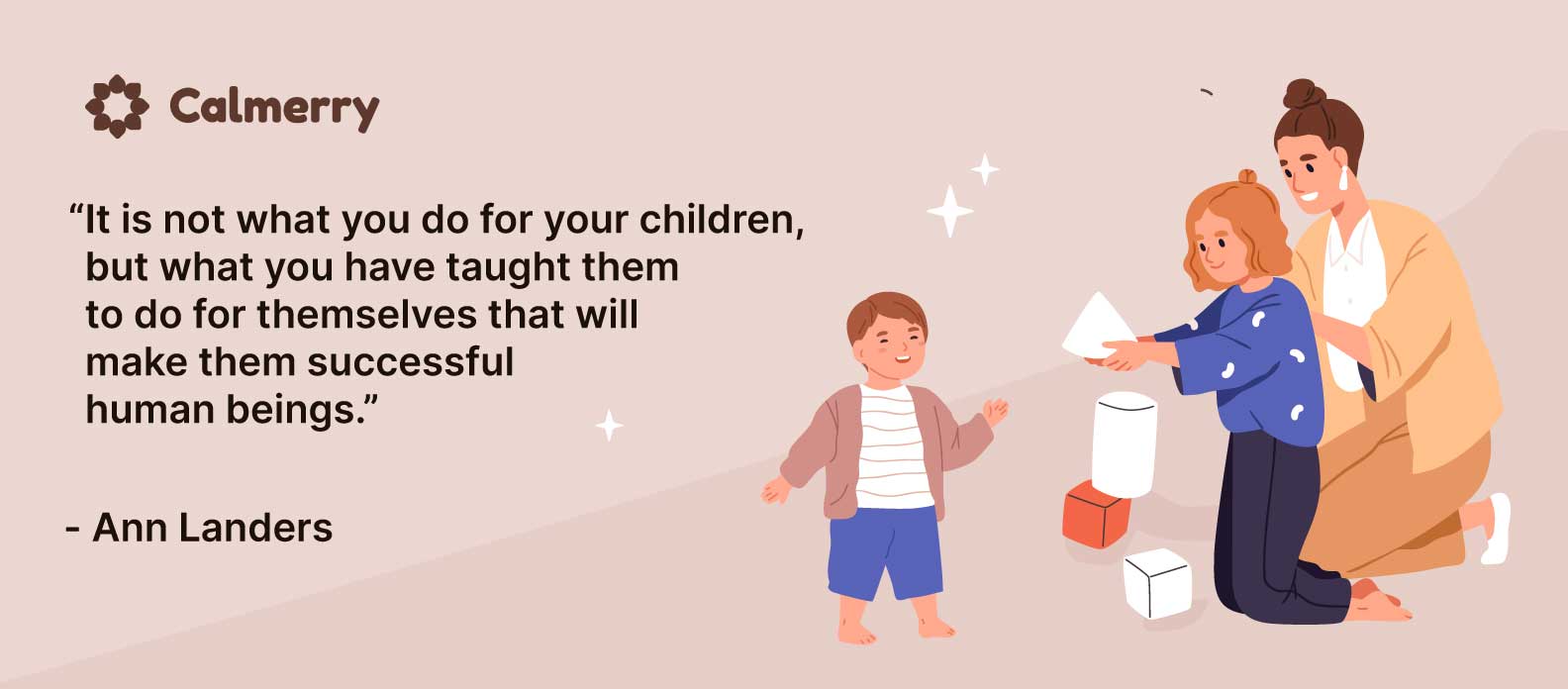How to Set Boundaries for Children Without Yelling, Threats, and Bribes

In this article
It’s common for parents to have doubts when it comes to setting boundaries for their children. That happens because some people often associate the word “boundary” with something negative. They think that setting particular boundaries for kids implies not taking their opinions and feelings into account.
But that isn’t the case. In fact, setting boundaries is an important aspect of parenting because children need reliably enforced norms, rules, and guidelines for their lives. This process signifies structure, regulation, and teaching. But it doesn’t imply disrespect.
So here is the important question: how do you set boundaries for kids in a healthy way, so they’re able to learn and still understand that you love them? Keep reading to find out.
What are the boundaries for kids?
Boundaries can be defined as the rules of the game of education. They allow parents to teach acceptable behaviors and transmit values to their children. Setting healthy boundaries with your children is a critical part of creating healthy relationships within your family.
Moreover, learning about boundaries early in life gives children life-long skills to navigate future relationships so that they’re less likely to make other people uncomfortable.
A child who grows up in a home with clear, healthy limits will learn to apply such boundaries in their own life. That means developing better self-control and the ability to make positive choices.
How to set boundaries for kids
Kids need limits and boundaries to feel safe and succeed in life, but establishing healthy parent-child boundaries and enforcing them is tricky. And it can be very frustrating when your kids repeatedly challenge the boundaries you set, so you may even wonder if it’s really worth the effort.
Let’s face it: kids will push your boundaries every day all the time because it’s in their nature to test us and see how far they can go. It’s just a part of their learning process as they grow up and become more independent.
Your children may even be upset when you uphold certain boundaries, but they’ll also feel safe and secure at the same time. And your task as a parent is to teach your kids to test your limits with respect, knowing that ultimately you are in charge.
It’s essential to begin teaching your children about boundaries very early on in their childhood. It means saying no to things that your children can’t or shouldn’t do and imposing certain consequences for not following the rules. It also means teaching them to overcome their feelings when they’re frustrated.
It’s not easy, but it’s one of the most fundamental tasks of parents. And if you don’t do it, then who will? Here are some ideas to help you set boundaries for kids.
1. Have clear rules
Kids need clear, fair rules and consistent consequences. You should explain to your child what the boundaries are and what will happen if they exceed them. Keep your instructions very brief and make sure they’re adapted to the child’s age.
After all, the most important thing is to explain what they can’t do and why.
If the rules are easy to follow and understand, your child is less likely to cross the line. So, your instructions should be impactful, directive, and closed-ended (without any possibility for misinterpretation). It’s better to reframe the negative in a positive way to create an invitation rather than a threat.

Don’t go into a long explanation or discussion with your younger child about, for example, why they need to go to bed early. Developmentally, your child won’t really be able to fully listen to a long explanation and remember this information the next time.
Instead, you may remind your child that if they don’t get ready for bed on time, they won’t have time for a favorite bedtime story. Such a tactic is much more likely to be effective.
2. Be firm and consistent
Consistency is key because it helps establish structure and discipline at home. That makes it easier for children to know how to stay within the limits you set for them.
So if you explain to your child that if they exceed X boundary, Y will happen, you must always keep your word. Then, they’ll know you’re very serious about the boundaries, and this will teach them to be accountable for their behavior.
If you don’t, you’ll send a clear message that the rules you set don’t mean much and don’t need to be respected. And children will constantly push the boundaries to manipulate you.
3. Check your body language and facial expression
When people communicate, non-verbal cues like gestures, facial expressions, and tone of voice carry huge importance. This applies when teaching children boundaries as well. Remember that it’s not just what you say, it’s also how you say it.
When teaching your child, it’s essential to speak with a firm voice, maintain appropriate eye contact, and have a neutral facial expression. And you should always stoop down to have eye contact at their level. This way, you won’t look so intimidating to the child.
Keep in mind that you’re unlikely to convince them you’re serious about the rules while smiling or laughing with them. Your actions should be congruent with what you say.
4. Follow through with the consequences
Make sure your child is aware beforehand of the consequences they’ll have if they don’t respect a boundary or limit. And always follow through on the consequences of inappropriate behavior.
Employ natural consequences when possible. They just make more sense and help associate negative outcomes with specific behavior. For example, if your child has not cleaned their room as instructed, missing out on a fun activity when they do clean it is not actually a punishment but a natural consequence.
You shouldn’t worry that your child will be upset or angry with you. It’s a part of the process of setting boundaries. Children need to learn what acceptable behavior is and what is not. This experience can also help them learn how to cope with negative emotions in a healthy way.
Moreover, in the long run, they’ll benefit from the boundaries you establish to keep them healthy and happy.
It’s also important to acknowledge your child’s efforts when they’ve stuck to the boundaries you’ve set. Children love to be praised for something they did and will be more motivated to continue sticking to your limits. This technique is called positive reinforcement.
5. Propose alternatives
You should also keep in mind that children need choices, and that’s especially important when you’re restricting their behavior or forbidding something. So you may propose some alternatives. This way, you’ll teach them not only what they can’t do but also what they can do.
For example, you can say, “You can’t do X, but you can do Y.” This way, you’ll promote appropriate and positive behavior.
6. Have developmentally appropriate expectations
It’s important to set age-appropriate boundaries that your child can understand. Take into account that certain things can only be done at certain ages and that they might be too advanced for your child.
Don’t set expectations that are too high. Instead, look for healthy expectations that are realistically appropriate for the child’s age, level of development, understanding, and ability to control their actions.
You can use them to track the progress of your child’s growth and let them know about their improvement to motivate them to stick to prosocial behavior.
And keep in mind that each child develops at their own rate. You’ll better understand your child’s behavior if you understand what they’re going through developmentally.
7. Set a good example
The best way to teach your children boundaries is to have healthy boundaries yourself and model them in your home. Remember, you should be a role model your child can rely on.

It’s important to show respect for each person in the household and ensure that everyone has the right to express their feelings appropriately and talk openly and honestly about any challenging issues.
Be open with your child and ask questions to make sure that they understand their boundaries and follow them.
And make it clear to your child that you’re always open to listening to them and respecting their wants and needs, while also considering the option of seeking support from an online therapist if they ever feel the need to discuss their feelings in a safe and confidential environment.
Why do children need boundaries?
Today, in many families, children’s voices or opinions are equal to those of their parents. There are some families where the child’s voice may actually take over.
And there are parents who may even fully sacrifice their own needs to make their children happy. They’re ready to adjust their plans and routines according to the demands and whims of the child.
While previous generations focused mostly on children’s behavior, today’s parents focus more on children’s emotions. But although it’s extremely important to hear and validate children’s feelings, parents still need to be in charge of creating a secure and stable environment for their kids.
Remember that you, as a parent, are responsible for setting healthy boundaries in the household to create an environment where your children can be heard and encouraged to develop self-awareness, patience, empathy, and more.

Here are some important reasons why parents need to be in charge of establishing boundaries to set the direction for a child’s emotional development:
Boundaries keep kids safe
When kids have no clear limits, they feel insecure. If parents allow their kids to have control over decision-making in their home, the balance of power shifts toward the child, and this is harmful to both parents and kids.
When children feel like they can easily convince their parents to do whatever they want, they may feel like they’re more powerful than their parents. The children may not realize it, but in fact, uncertainty and the idea that they can dominate adults who are supposed to be in charge will make them feel anxious and insecure.
They need boundaries set by parents (and not negotiated by the child) to have a sense of security. When parents set and monitor rules and routines like bedtimes, meal times, homework time, screen time, and chores, that creates a sense of predictability in a child’s life and reduces uncertainty and anxiety.
A child’s brain is not fully developed
Children shouldn’t be given decision-making power over adults because they have undeveloped prefrontal lobes. As a result, children’s intelligence differs from adults’ in quality.
That means children think differently from adults and see the world in different ways.
Intuitive thinking
For example, children aged 2-7 can think about things symbolically. Their thinking is intuitive (based on subjective judgments about situations) and egocentric (centered on the child’s own view of the world). They can’t make big decisions because their brain is not equipped for that.
Concrete thinking
Children aged 8-11 develop concrete thinking – they begin to think logically about concrete events. They love rules and often consider all things in the world to be black or white. During this stage, children also start thinking about how other people may think and feel.
Abstract thinking
It’s only from about the age of 12 that children start to develop abstract thinking and can follow a logical argument without having to think in terms of specific examples. That’s why adolescence is a more appropriate time to start experimenting with rules and limits.
But parents need to be in charge of setting boundaries with teenagers because they’re still developing the prefrontal controls around impulsivity, learning to manage emotional reactions, decision-making, and problem-solving.
When establishing boundaries, you should always take into account your child’s unique developmental stage and what is an appropriate level of choice for them to have.
There is no sense in negotiating things with 5-year-old children as if they were mini-adults. They’re unlikely to fully understand all the gradations of why certain rules change.
Having a solid sense of self
Small children are naturally selfish. It’s a normal stage of development in which they work to get their needs met and can’t understand other people’s needs and desires.
But lack of boundaries may provoke the development of narcissism and entitlement, and kids may continue to believe that the world revolves around them.
Not having limits encourages kids to think that other people exist just to meet their needs, and they feel very disappointed when they don’t always get what they want.

Parental boundaries help children develop healthy self-esteem that allows them to protect and care for themselves while recognizing and respecting the needs of other people. They learn to be more patient and mature, and more connected to the real world.
Healthy boundaries give kids some freedom and autonomy to explore and develop a sense of identity. Understanding the meaning of limits helps children understand and respect their own needs as well as the needs of others.
As a result, they develop greater empathy and self-awareness. Children learn how to gain self-control, which allows them to regulate their behavior so it is socially acceptable.
Kids learn from struggling
Struggle is an essential component of growth. Kids need to struggle to develop new skills like walking, talking, or learning to read.
Struggle builds character and resilience, helps us mature, and enables us to grow in all aspects of our lives and reach our full potential.
But when a child is brought up with the expectation that they’ll always be in charge, they want all things to be easy, and that’s not how the real world is. They also expect that parents will remove any struggle for them and fix their disappointments.
As a result, a child will have a hard time with the rules and boundaries they encounter at school and in adult life.
So it’s good and healthy when a child struggles a bit with a certain limit or rule. When you, as a parent, set particular boundaries for your child, you’re not trying to make them happy at that moment.
You’re trying to help your child develop essential skills that will allow them to be successful later in life. And that’s more important.
Bottom line
Setting boundaries and respecting the needs of others is an important skill for everyone to master to be successful in life. It helps us regulate our behavior and build strong, healthy relationships based on respect and open communication.
Setting boundaries for children is one of the most important aspects of parenting. It’s your duty as a parent to teach your kids about healthy boundaries from a young age to provide a solid foundation for their futures.
The earlier they learn about their own limits and understand the importance of respecting others’, the more prepared they’ll be for the real world and the easier it will be for them to establish healthy relationships as adults.
Therapy for parental burnout
Being a parent is one of the most rewarding experiences, but it’s also difficult. We often put a lot of pressure on ourselves to do basically everything every single day. That may lead to exhaustion and even parental burnout.
That’s why you should be kind to yourself and practice self-care.
If you notice any signs of burnout, it’s important to reach out for professional mental health support. Calmerry therapists are always ready to help you learn coping skills to manage stress and be equipped to face the challenges of life.
online therapy
live video session

